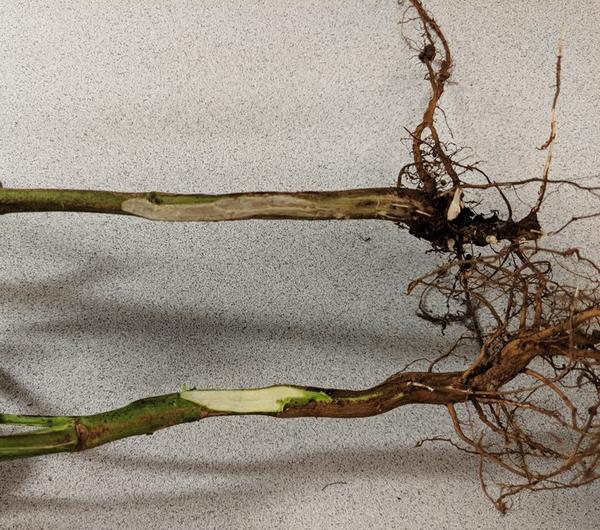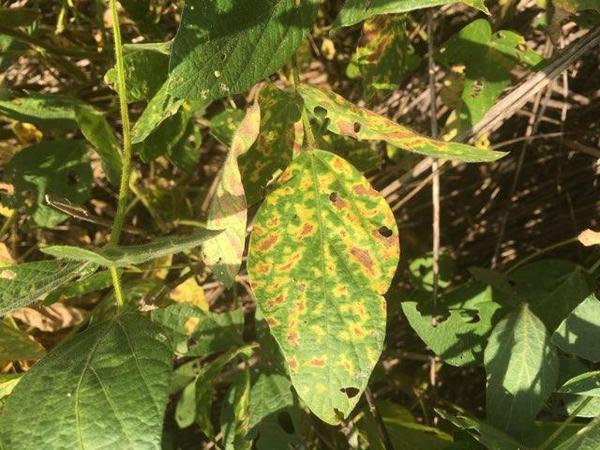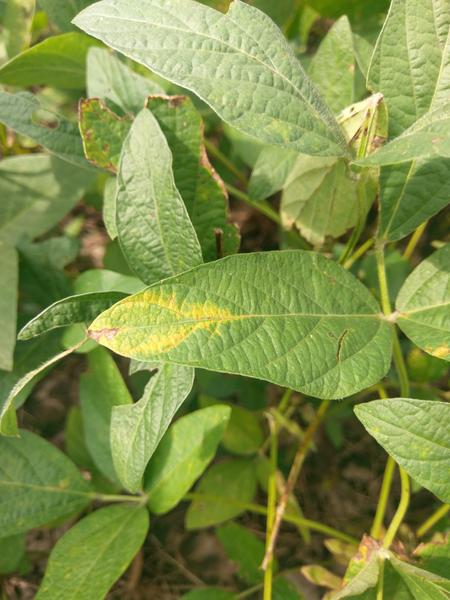Introduction
Soybean Sudden Death Syndrome (SDS) first appeared in Arkansas in 1971 and has since spread to almost every soybean producing state. Afflicted plants suffer from flower and pod abortion, reduction in seed size and vigor, and extreme yield losses. The severity of the symptoms depends on the maturity of the plant at the time of infection. SDS rarely affects plants in North Carolina, but losses are seen when infections are concurrent with soybean cyst nematode infections or cool, wet environmental conditions.
Pathogen and Life Cycle
The causal agent of Soybean Sudden Death Syndrome (SDS) is the soil borne fungus Fusarium virguliforme (formerly F. solani f. sp. glycines). F. virguliforme overwinters as chlamydospores (resting spores). The fungus begins attacking plants roots about 2-3 weeks after germination, but plant symptoms are not observed until later in the growing season. F. virguliforme reproduces by producing macroconidia to disperse throughout the soil and spread to new host plants. Once inside the plant, F. virguliforme produces toxins that cause plant symptoms.
Host Crops
Soybean (Glycine max) is the primary host for this pathogen. It can also infect alfalfa and results in similar symptoms to those found in soybean. Sugar beets and canola do not show symptoms when infected, but do have severely reduced biomass.
Symptoms and Identification
Symptoms begin in the roots and include necrosis and dieback, similar to other root diseases (Figure 1). The vascular tissue of the taproot becomes brown and discolored. This discoloration can extend upward to the lower stem, but does not invade much beyond a couple of inches above the soil line (Figure 2). Occasionally, blue-green masses of macroconidia may be visible on roots close to the soil line (Figure 3). Later in the season, usually after plants have flowered, the fungal toxin migrates up through the vascular tissue into the canopy. The leaves initially develop intravenous chlorotic spots that soon become necrotic (Figure 4). In the advanced stages of the disease, only the central vein remains green and leaflets begin to detach from the petioles.
Diseases With Similar Symptoms
SDS can be easily confused with other root rot diseases, including Fusarium wilt, Phytophthora root rot, and white mold.
The foliar symptoms caused by SDS can sometimes be mistaken for a virus, like soybean vein necrosis virus (Figure 5).
Management
Crop Rotations
Rotation with wheat or oats reduce SDS damage the greatest of rotations assessed. Maize, cotton, sorghum and rice to not appear to reduce disease pressure and are not recommended. Rotations with at least two years out of soybean production are best in severely affected fields.
Resistant Cultivars
Planting cultivars with some resistance to the disease can help reduce symptom severity and improve yield.
Irrigation Management
Disease is worse in years with heavy rainfall or in fields with heavy irrigation. Limiting excess irrigation and improving soil drainage where possible will help to reduce disease losses.
Sanitation
Tools and farming equipment can spread the fungal spores between fields. Make sure all tools and materials rinsed of soil debris and sterilized with bleach or ethanol when moving to a different field.
Chemical Control
Seed treatments containing fluopyram work well against this disease, since the pathogen attacks the plant early in the season. Losses by SDS in North Carolina often do not warrant the use of chemical controls, but seed treatments containing fluopyram have had positive yield responses in seed treatment trials for SDS management.
Useful Resources
- The NC State University Plant Disease and Insect Clinic provides diagnostics and control recommendations
- The NC State Extension Plant Pathology portal provides information on crop disease management
- The North Carolina Agricultural Chemicals Manual provides pesticide information for common diseases of North Carolina. The manual recommendations do not replace those described on the pesticide label, and the label must be followed.
Acknowledgements
This factsheet was prepared by the NC State University Field Crops and Tobacco Pathology Lab in 2019.
- Check out our Facebook and our Twitter!
Publication date: May 8, 2019
N.C. Cooperative Extension prohibits discrimination and harassment regardless of age, color, disability, family and marital status, gender identity, national origin, political beliefs, race, religion, sex (including pregnancy), sexual orientation and veteran status.






